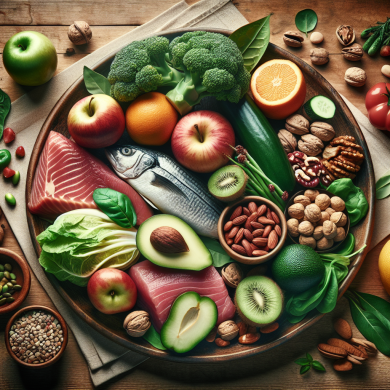Paleo Diet Essentials: A Beginner’s Guide
Introduction to the Paleo Diet
The Paleo diet, also known as the Paleolithic or “caveman” diet, is a nutritional plan that seeks to emulate the dietary habits of our prehistoric ancestors. The premise is simple: consume foods that were available to humans before the advent of agriculture, about 10,000 years ago. By focusing on lean meats, fish, fruits, vegetables, nuts, and seeds, the Paleo diet aims to promote optimal health by aligning our diet with our genetics.
The Philosophy Behind the Paleo Diet
The Paleo diet is based on the concept that modern eating habits, characterized by processed foods and grains, are misaligned with our genetic makeup. Proponents argue that this mismatch contributes to the prevalence of chronic diseases like obesity, diabetes, and heart disease. By returning to a diet that mimics that of our Paleolithic ancestors, we can improve our health and well-being.
Core Components of the Paleo Diet
Allowed Foods
- Lean Meats: Grass-fed beef, lamb, chicken, turkey, and other wild game.
- Fish and Seafood: Salmon, mackerel, sardines, and shellfish.
- Fruits: Berries, apples, bananas, and citrus fruits.
- Vegetables: Leafy greens, broccoli, carrots, and tomatoes.
- Nuts and Seeds: Almonds, walnuts, sunflower seeds, and pumpkin seeds.
- Healthy Fats: Olive oil, coconut oil, and avocado oil.
Foods to Avoid
- Grains: Wheat, oats, barley, and rice.
- Legumes: Beans, lentils, peanuts, and peas.
- Dairy: Milk, cheese, yogurt, and butter.
- Processed Foods: Sugary snacks, pre-packaged meals, and artificial sweeteners.
- Refined Sugars and Salt: Table sugar, high-fructose corn syrup, and iodized salt.
Benefits of the Paleo Diet
Improved Nutrient Intake
The Paleo diet encourages the consumption of whole, unprocessed foods that are rich in essential nutrients. By emphasizing fresh fruits, vegetables, and lean proteins, followers of the Paleo diet often experience an increase in their intake of vitamins, minerals, and antioxidants, which are crucial for maintaining overall health.
Weight Loss and Management
By eliminating processed foods and refined sugars, the Paleo diet can help individuals achieve and maintain a healthy weight. The diet’s focus on protein-rich foods can also promote satiety and reduce overall calorie intake, which may lead to weight loss over time.
Reduced Risk of Chronic Diseases
A diet rich in whole foods and low in processed ingredients has been linked to a decreased risk of chronic diseases such as obesity, diabetes, and cardiovascular disease. The Paleo diet’s emphasis on healthy fats and lean proteins can support heart health, while its exclusion of refined sugars may help regulate blood sugar levels.
Challenges and Considerations
Social and Practical Challenges
Adopting the Paleo diet can be challenging in social settings and when dining out, as many common foods are restricted. Planning and preparation are essential to successfully adhering to the diet, and individuals may need to develop new cooking skills and habits.
Nutrient Deficiencies
While the Paleo diet can provide a wealth of nutrients, it may also result in certain deficiencies if not carefully managed. The exclusion of grains and dairy can lead to a lack of calcium, vitamin D, and other nutrients. It’s important for those on the Paleo diet to seek alternative sources of these nutrients through foods like leafy greens, fish, and fortified products.
Cost and Accessibility
The emphasis on high-quality, organic, and grass-fed meats can make the Paleo diet more expensive than other dietary plans. Additionally, not everyone has easy access to these foods, which can make sticking to the diet difficult for some individuals.
Practical Tips for Starting the Paleo Diet
Gradual Transition
For those new to the Paleo diet, a gradual transition can be more sustainable than an abrupt change. Begin by incorporating more Paleo-friendly foods into your diet while slowly reducing the consumption of non-Paleo items. This approach allows your body to adjust and can make the transition smoother.
Meal Planning and Preparation
Planning meals ahead of time is crucial for success on the Paleo diet. Invest time in meal prepping, batch cooking, and finding Paleo recipes that suit your taste preferences. Having Paleo-friendly snacks on hand can also help curb cravings and keep you on track.
Find Support and Resources
Joining a community of like-minded individuals can provide motivation and support. There are numerous online forums, social media groups, and local meetups dedicated to the Paleo lifestyle. Additionally, consider consulting with a registered dietitian or nutritionist to ensure you’re meeting your nutritional needs.
Conclusion
The Paleo diet offers a return to a simpler way of eating, focusing on whole, nutrient-dense foods that align with our evolutionary history. While there are challenges to adopting this lifestyle, the potential benefits to health and well-being make it a compelling choice for many. By understanding the core principles and being mindful of potential pitfalls, beginners can successfully navigate the Paleo diet and enjoy its many advantages.















Add comment